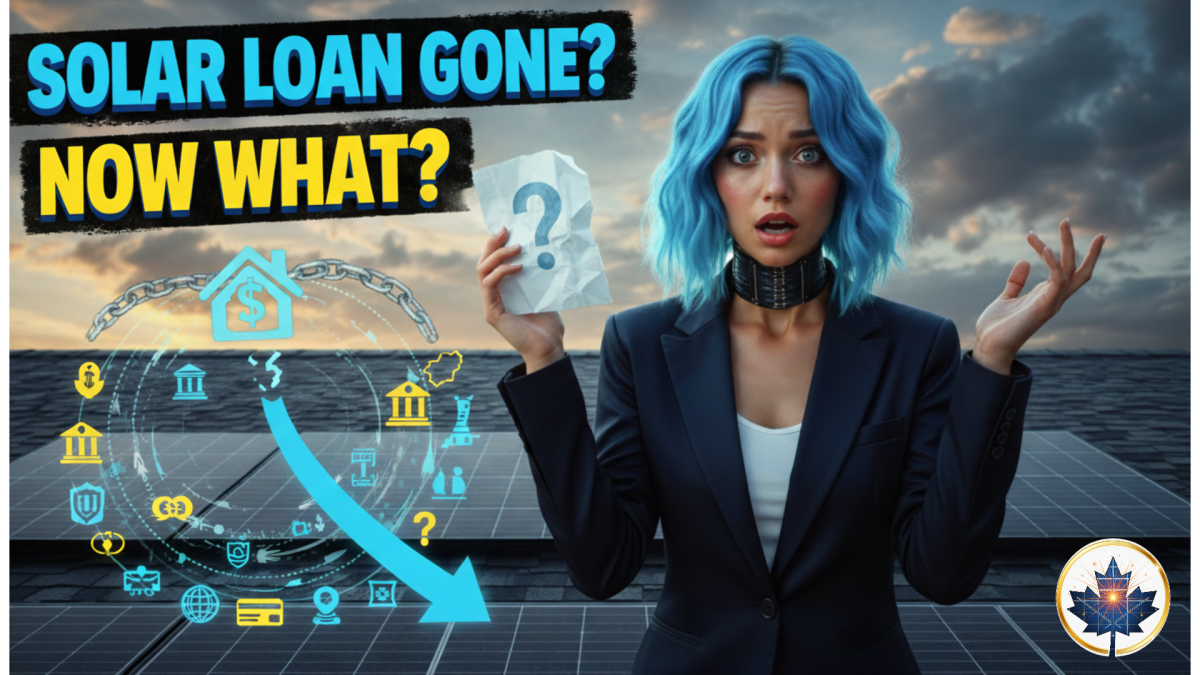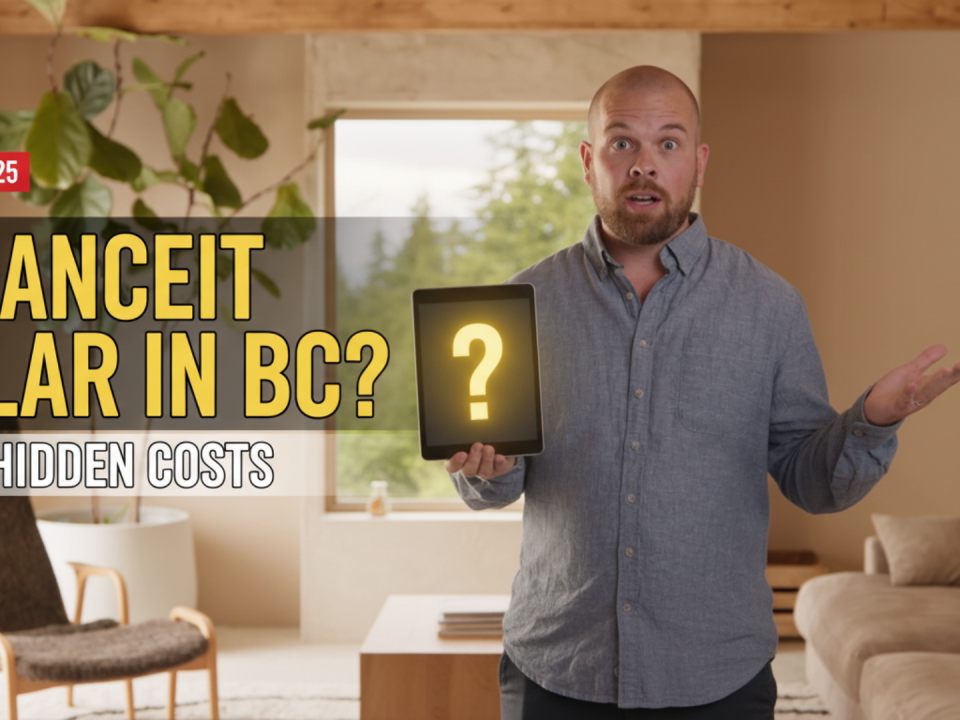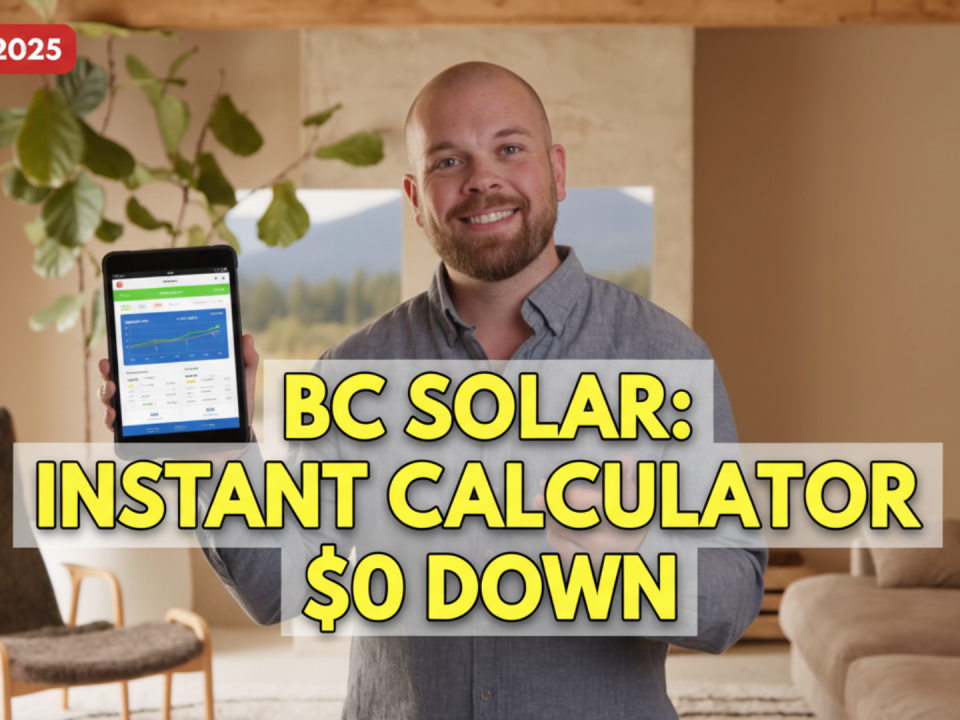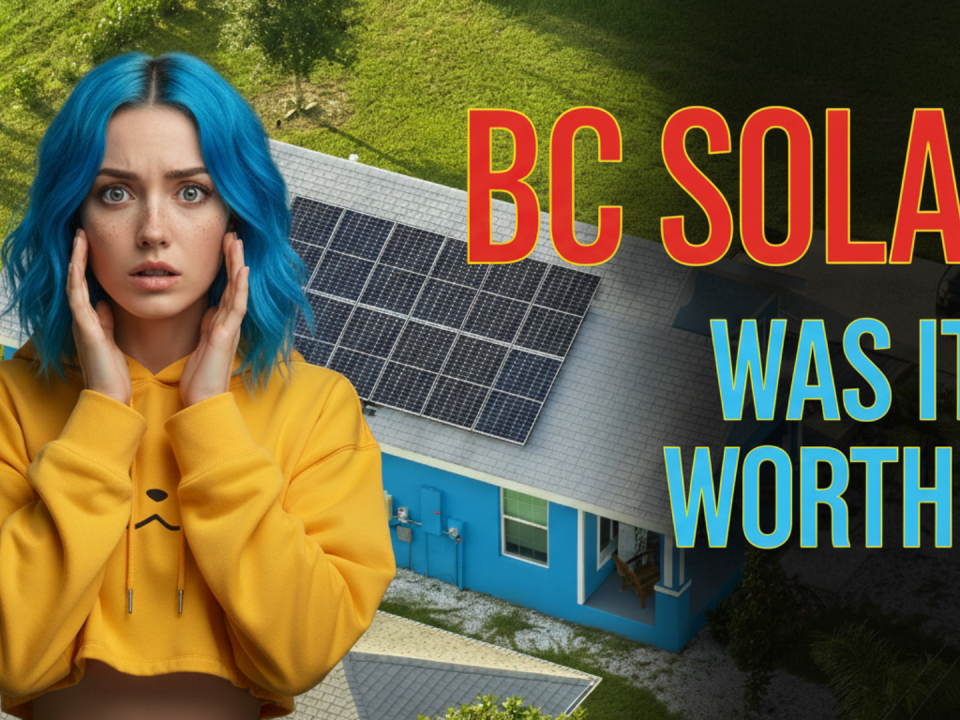
The Canada Greener Homes Loan and Grant Are Gone. Now What?
September 26, 2025
Read This Before You Sign That Solar Contract in Canada
September 30, 2025The federal government’s Canada Greener Homes Loan program officially closed its doors to new applicants in March 2024. Let’s be direct: this stings. That interest-free loan was a game-changer for thousands of Canadians, making the switch to solar energy far more accessible. I saw it firsthand with countless clients who finally had a clear path to energy independence. Its sudden end left many homeowners wondering, “Now what?”
If you were counting on that loan, it’s easy to feel like you’ve missed your chance. But I’m here to tell you that’s not the case. My name is Vitaliy Lano, and I’ve spent the last 12 years in the home improvement and sustainability field. At SolarEnergies.ca, our slogan is “Canada goes Solar,” and I stand by that. The end of one federal program doesn’t stop the sun from shining, and it doesn’t end the financial sense solar makes.
The truth is, financing solar has always had multiple paths. The Greener Homes Loan was just the most publicized one. Now, we need to look at the other options—some of which are surprisingly good. This guide will walk you through the real, practical ways to finance a solar panel system in Canada today. We’ll look at bank loans, credit union offers, installer financing, and the specific programs still running in key provinces.
The Big Picture: Why Solar Still Makes Financial Sense
Even without the 0% loan, the financial case for solar is stronger than ever. One of the biggest hurdles for many people are the common myths about solar panels that just aren’t true for Canada. Here’s why the investment works:
- Soaring Electricity Rates: Hydro costs are not going down. Across Canada, electricity prices have been steadily climbing. A recent report from the Financial Post noted that some provinces saw rate increases of over 5% in the last year alone. When you generate your own power, you protect yourself from these unpredictable hikes.
- Increased Home Value: A study by the Appraisal Institute of Canada found that homes with solar panel systems can sell for more than comparable homes without them. Buyers see the long-term value in lower electricity bills.
- Net Metering Programs: Every province with a viable solar market has a program that lets you sell excess electricity back to the grid. This allows you to send power your panels generate back for credits on your bill. It’s like having a savings account with your utility provider.
The upfront cost is the hurdle. The price of a complete home solar system in Canada can be anywhere from $15,000 to $30,000, depending on its size and your location. The Greener Homes Loan spread that cost over 10 years with 0% interest. Our goal now is to replicate that manageable payment structure as closely as possible to ensure solar panels pay for themselves.
Your New Solar Financing Toolkit: Where to Look for Funds
Without the federal loan, your financing strategy falls into three main categories: your own bank or credit union, the solar installer’s financing partners, or local government programs. Let’s break down the pros and cons of each.
1. Traditional Lenders: Banks and Credit Unions
Your first stop should often be the financial institution you already have a relationship with. They have a vested interest in keeping your business.
Major Banks (RBC, TD, Scotiabank, BMO, CIBC)
The big five banks are all promoting “green” or “eco-friendly” financing options. These are typically secured lines of credit or personal loans with a slight marketing spin.
- Home Equity Line of Credit (HELOC): This is often the most recommended option. If you have equity built up in your home, you can secure a line of credit against it.
- Interest Rates: Typically variable, tied to the prime rate. As of late 2024, you might see rates in the range of Prime + 0.5% to Prime + 1.5%. This is significantly lower than an unsecured loan.
- Pros: Lower interest rates, flexible repayment terms, and you can borrow what you need as you need it.
- Cons: Your home is the collateral. You need to have sufficient equity, which can be a barrier for new homeowners.
- “Green” Personal Loans: Some banks offer specific personal loans for energy-efficient upgrades. For example, RBC has its “Energy Saver Loan,” and BMO has a similar program. While they are marketed as special, they are often just standard personal loans, sometimes with a minor rate discount (perhaps 0.25% to 0.5% off their standard rate).
- Interest Rates: Expect rates from 7% to 12% or higher for an unsecured loan, depending on your credit score.
Tip for Bank Negotiations: When you talk to your bank, don’t just ask for a loan. Explain that you are making a capital improvement to your home that will increase its value and reduce your monthly expenses. Provide them with your solar installer’s quote and potential energy savings. This frames it as a sound investment, not just another debt.
Credit Unions: The Community-Focused Alternative
I often steer people towards their local credit unions. They are member-owned and frequently have a stronger mandate to support community and environmental projects.
- Dedicated Green Loans: Credit unions like Vancity in British Columbia or Meridian in Ontario have been leaders in green financing. They often design loan products specifically for solar installations.
- Interest Rates: Often more competitive than big banks’ unsecured loans. It’s not uncommon to see fixed rates a percentage point or two lower because their focus is on community benefit, not just profit.
- Pros: More personalized service, potentially better rates, and a local focus. They may be more flexible with their lending criteria than large national banks.
- Cons: You need to be a member. Their reach is local, so you need to find one serving your area.
2. Solar Installer Financing: The “0% Interest” Question
Many large solar installation companies offer their own financing. This is a very convenient option, as it bundles the entire process—quote, installation, and financing—into a single package. These companies typically partner with third-party finance firms like Financeit, Snap Home Finance, or Fairstone. Be wary of potential solar panel scams in Canada and always do your research.
They often advertise 0% financing. This sounds identical to the old Greener Homes Loan, but it’s crucial to understand how it works.
There is no such thing as a free loan. The cost of that 0% interest rate is paid for by the installer to the finance company. To cover that cost, the installer usually increases the total price of the solar system. I once got two quotes for a project on my own property. The cash price was $22,000. The “0% financing” price for the exact same system from the same company was nearly $26,000.
A Closer Look: The Polaron Model
Let’s use a specific example: Polaron Solar. They are one of Canada’s largest residential solar installers and heavily promote affordable monthly payment options. Their primary offering is often a 0% interest loan, typically spread over a 12-year (144-month) term, though other terms may be available.
This is a powerful marketing tool because it provides homeowners with a fixed, predictable monthly payment that can often be close to what they were already paying for electricity. It removes the sticker shock of the upfront cost.
But let’s look at the numbers. Polaron’s model is a classic example of how 0% financing works in this industry. To offer that 0% rate through their financial partners, they pay a significant “dealer fee.” This fee is then built into the total price of the system.
Let’s create a realistic comparison based on industry-standard pricing:
| Scenario | System Price | Interest Rate | Loan Term | Monthly Payment | Total Cost |
|---|---|---|---|---|---|
| Polaron “0% Deal” | $28,500 | 0% | 12 years | ~$198 | $28,500 |
| Same System at Cash Price | $23,000 | 6.5% (HELOC) | 12 years | ~$223 | ~$32,100 |
| Same System at Cash Price | $23,000 | 8% (Credit Union) | 12 years | ~$244 | ~$35,100 |
Here’s what this table tells us:
- The capital cost of the Polaron 0% deal is significantly higher—in this case, by $5,500. This is the hidden cost of “free” financing.
- The monthly payment for the 0% deal is the lowest, which is its main appeal. It makes the project seem more affordable on a month-to-month basis.
- The total cost over the loan’s life is actually lowest with the 0% plan in this specific comparison. Why? Because the interest you’d pay on a traditional loan for the lower cash price adds up to more than the initial $5,500 markup over 12 years.
Is it a bad deal? Absolutely not, for the right person. If you don’t have access to a low-interest HELOC or prefer the simplicity and budget certainty of a fixed $0-interest payment, Polaron’s model is very effective. The key is transparency.
Tip for Installer Financing: Always ask any installer, including Polaron, for two quotes: the cash price and the financed price. Knowing the right questions to ask solar companies is critical. This transparency allows you to compare the true cost of borrowing and decide if the convenience and low monthly payment of the 0% offer is worth the higher principal.
Provincial and Municipal Programs: A Patchwork of Support
With the federal program gone, provincial and local incentives have become much more important. This is where you can find grants, rebates, and unique financing models that can significantly lower your costs. The landscape is constantly changing, so always check your provincial and municipal government websites for the latest information.
Here’s a breakdown of what’s happening in key provinces.
Alberta
Solar panels in Alberta have a strong outlook, but support is localized.
- Clean Energy Improvement Program (CEIP): This is arguably the best financing model in the country right now. Available in municipalities like Edmonton, Calgary, Canmore, and Lethbridge, CEIP allows you to finance your solar installation and pay it back through your property tax bill over a long term (up to 20 years). The cost of solar panels in Edmonton, for example, can be managed effectively through this program.
- How it works: The municipality provides the loan, which is tied to the property, not the owner. If you sell your home, the new owner takes over the payments.
- Interest Rates: Very competitive, often at or near the municipality’s cost of borrowing.
- Link: Alberta CEIP
British Columbia
Our guide to solar panels in BC shows a mix of tax savings and regional rebates.
- PST Exemption: There is no Provincial Sales Tax (PST) on solar panel systems, which saves you 7% right off the top.
- BC Hydro & FortisBC Net Metering: Strong net metering programs give you full retail value for the excess power you generate.
- Local Rebates: Some municipalities and regional districts offer top-up grants. For example, the Regional District of Nanaimo has offered rebates in the past. These programs can be temporary, so you need to check with your local government.
Ontario
Our Ontario solar panel guide shows the situation is more focused on net metering benefits rather than large upfront grants.
- Net Metering: Like B.C., the ability to earn credits for excess generation is the primary financial incentive.
- Municipal Programs: Some cities, like Toronto, have programs to encourage green energy. Toronto’s Home Energy Loan Program (HELP) provides low-interest loans for a variety of energy-saving upgrades, including solar.
- Link: Toronto HELP Program
Nova Scotia
Nova Scotia remains a leader in supporting residential solar, as detailed in our guide to solar panels in Nova Scotia.
- SolarHomes Program: This program, run by Efficiency Nova Scotia, provides a rebate on the cost of your solar system. You can learn more in our breakdown of Nova Scotia’s solar rebates. The rebate is calculated per watt of installed capacity, up to a maximum amount (e.g., $0.30/watt up to $3,000).
- This rebate can be combined with other financing options, directly reducing the principal of your loan.
A Personal Story: My Neighbor’s Journey
A few months ago, my neighbor, Dave, was ready to install solar. He’d done his homework and was approved for the Greener Homes Loan. Then, the program was cancelled. He was frustrated and ready to give up. We sat down and went through the options I’ve outlined here.
He has good credit and has been in his home for 15 years. He first went to his big bank, but they weren’t particularly helpful and offered him a standard unsecured loan at 9.5%. Discouraged, he almost signed a 0% financing deal with an installer that padded his quote by $4,500.
On my advice, he went to a local credit union. They offered him a “Green Improvement Loan” at a fixed 6.2% rate over 12 years. The monthly payment was affordable, and the total cost of borrowing was thousands less than the inflated 0% deal. He went with the credit union, got his system installed at the lower cash price, and couldn’t be happier. His experience proves that while the ‘easy button’ of the federal loan is gone, a smarter, more affordable deal is often waiting for those who explore all their options.
Your Step-by-Step Action Plan
Feeling overwhelmed? Don’t be. Here is a clear, step-by-step plan to secure financing for your solar project.
- Get 2-3 Solar Quotes: Before you can get financing, you need to know how much you need to borrow. Contact reputable local installers and get detailed quotes. Ask for the cash price.
- Check for Local Incentives: Go to your provincial and municipal government websites. Search for “solar rebates,” “energy efficiency grants,” or programs like CEIP or HELP. This could reduce the amount you need to finance.
- Talk to Your Credit Union and Bank: Approach them with your solar quotes and information on energy savings. Ask specifically about HELOCs and any green loan programs they offer. Get firm quotes on interest rates and terms.
- Ask Installers for Financing Options: Ask your preferred installer for their financing quote. Remember to request the cash price as well, so you can calculate the true cost of their “0% interest” offer.
- Compare Your Options in a Spreadsheet: Lay out all your offers side-by-side. Compare the principal amount, interest rate, loan term, monthly payment, and total lifetime cost of the loan. The lowest monthly payment isn’t always the cheapest option overall. When comparing, think about the best residential solar panels in Canada to ensure you’re getting quality hardware.
- Make Your Decision: Choose the financing path that offers the best balance of affordability and long-term value for your situation.
The journey to solar energy in Canada has a new roadmap. The simple, single-lane highway of the Greener Homes Loan has been replaced by a network of different routes. It requires a bit more navigation, but the destination—energy independence, lower bills, and a more sustainable home—is still very much within reach.
The federal government’s Canada Greener Homes Loan program officially closed its doors to new applicants in March 2024. Let’s be direct: this stings. That interest-free loan was a game-changer for thousands of Canadians, making the switch to solar energy far more accessible. I saw it firsthand with countless clients who finally had a clear path to energy independence. Its sudden end left many homeowners wondering, “Now what?”
If you were counting on that loan, it’s easy to feel like you’ve missed your chance. But I’m here to tell you that’s not the case. My name is Vitaliy Lano, and I’ve spent the last 12 years in the home improvement and sustainability field. At SolarEnergies.ca, our slogan is “Canada goes Solar,” and I stand by that. The end of one federal program doesn’t stop the sun from shining, and it doesn’t end the financial sense solar makes.
The truth is, financing solar has always had multiple paths. The Greener Homes Loan was just the most publicized one. Now, we need to look at the other options—some of which are surprisingly good. This guide will walk you through the real, practical ways to finance a solar panel system in Canada today. We’ll look at bank loans, credit union offers, installer financing, and the specific programs still running in key provinces.
The Big Picture: Why Solar Still Makes Financial Sense
Even without the 0% loan, the financial case for solar is stronger than ever. One of the biggest hurdles for many people are the common myths about solar panels that just aren’t true for Canada. Here’s why the investment works:
- Soaring Electricity Rates: Hydro costs are not going down. Across Canada, electricity prices have been steadily climbing. A recent report from the Financial Post noted that some provinces saw rate increases of over 5% in the last year alone. When you generate your own power, you protect yourself from these unpredictable hikes.
- Increased Home Value: A study by the Appraisal Institute of Canada found that homes with solar panel systems can sell for more than comparable homes without them. Buyers see the long-term value in lower electricity bills.
- Net Metering Programs: Every province with a viable solar market has a program that lets you sell excess electricity back to the grid. This allows you to send power your panels generate back for credits on your bill. It’s like having a savings account with your utility provider.
The upfront cost is the hurdle. The price of a complete home solar system in Canada can be anywhere from $15,000 to $30,000, depending on its size and your location. The Greener Homes Loan spread that cost over 10 years with 0% interest. Our goal now is to replicate that manageable payment structure as closely as possible to ensure solar panels pay for themselves.
Your New Solar Financing Toolkit: Where to Look for Funds
Without the federal loan, your financing strategy falls into three main categories: your own bank or credit union, the solar installer’s financing partners, or local government programs. Let’s break down the pros and cons of each.
1. Traditional Lenders: Banks and Credit Unions
Your first stop should often be the financial institution you already have a relationship with. They have a vested interest in keeping your business.
Major Banks (RBC, TD, Scotiabank, BMO, CIBC)
The big five banks are all promoting “green” or “eco-friendly” financing options. These are typically secured lines of credit or personal loans with a slight marketing spin.
- Home Equity Line of Credit (HELOC): This is often the most recommended option. If you have equity built up in your home, you can secure a line of credit against it.
- Interest Rates: Typically variable, tied to the prime rate. As of late 2024, you might see rates in the range of Prime + 0.5% to Prime + 1.5%. This is significantly lower than an unsecured loan.
- Pros: Lower interest rates, flexible repayment terms, and you can borrow what you need as you need it.
- Cons: Your home is the collateral. You need to have sufficient equity, which can be a barrier for new homeowners.
- “Green” Personal Loans: Some banks offer specific personal loans for energy-efficient upgrades. For example, RBC has its “Energy Saver Loan,” and BMO has a similar program. While they are marketed as special, they are often just standard personal loans, sometimes with a minor rate discount (perhaps 0.25% to 0.5% off their standard rate).
- Interest Rates: Expect rates from 7% to 12% or higher for an unsecured loan, depending on your credit score.
Tip for Bank Negotiations: When you talk to your bank, don’t just ask for a loan. Explain that you are making a capital improvement to your home that will increase its value and reduce your monthly expenses. Provide them with your solar installer’s quote and potential energy savings. This frames it as a sound investment, not just another debt.
Credit Unions: The Community-Focused Alternative
I often steer people towards their local credit unions. They are member-owned and frequently have a stronger mandate to support community and environmental projects.
- Dedicated Green Loans: Credit unions like Vancity in British Columbia or Meridian in Ontario have been leaders in green financing. They often design loan products specifically for solar installations.
- Interest Rates: Often more competitive than big banks’ unsecured loans. It’s not uncommon to see fixed rates a percentage point or two lower because their focus is on community benefit, not just profit.
- Pros: More personalized service, potentially better rates, and a local focus. They may be more flexible with their lending criteria than large national banks.
- Cons: You need to be a member. Their reach is local, so you need to find one serving your area.
2. Solar Installer Financing: The “0% Interest” Question
Many large solar installation companies offer their own financing. This is a very convenient option, as it bundles the entire process—quote, installation, and financing—into a single package. These companies typically partner with third-party finance firms like Financeit, Snap Home Finance, or Fairstone. Be wary of potential solar panel scams in Canada and always do your research.
They often advertise 0% financing. This sounds identical to the old Greener Homes Loan, but it’s crucial to understand how it works.
There is no such thing as a free loan. The cost of that 0% interest rate is paid for by the installer to the finance company. To cover that cost, the installer usually increases the total price of the solar system. I once got two quotes for a project on my own property. The cash price was $22,000. The “0% financing” price for the exact same system from the same company was nearly $26,000.
A Closer Look: The Polaron Model
Let’s use a specific example: Polaron Solar. They are one of Canada’s largest residential solar installers and heavily promote affordable monthly payment options. Their primary offering is often a 0% interest loan, typically spread over a 12-year (144-month) term, though other terms may be available.
This is a powerful marketing tool because it provides homeowners with a fixed, predictable monthly payment that can often be close to what they were already paying for electricity. It removes the sticker shock of the upfront cost.
But let’s look at the numbers. Polaron’s model is a classic example of how 0% financing works in this industry. To offer that 0% rate through their financial partners, they pay a significant “dealer fee.” This fee is then built into the total price of the system.
Let’s create a realistic comparison based on industry-standard pricing:
| Scenario | System Price | Interest Rate | Loan Term | Monthly Payment | Total Cost |
|---|---|---|---|---|---|
| Polaron “0% Deal” | $28,500 | 0% | 12 years | ~$198 | $28,500 |
| Same System at Cash Price | $23,000 | 6.5% (HELOC) | 12 years | ~$223 | ~$32,100 |
| Same System at Cash Price | $23,000 | 8% (Credit Union) | 12 years | ~$244 | ~$35,100 |
Here’s what this table tells us:
- The capital cost of the Polaron 0% deal is significantly higher—in this case, by $5,500. This is the hidden cost of “free” financing.
- The monthly payment for the 0% deal is the lowest, which is its main appeal. It makes the project seem more affordable on a month-to-month basis.
- The total cost over the loan’s life is actually lowest with the 0% plan in this specific comparison. Why? Because the interest you’d pay on a traditional loan for the lower cash price adds up to more than the initial $5,500 markup over 12 years.
Is it a bad deal? Absolutely not, for the right person. If you don’t have access to a low-interest HELOC or prefer the simplicity and budget certainty of a fixed $0-interest payment, Polaron’s model is very effective. The key is transparency.
Tip for Installer Financing: Always ask any installer, including Polaron, for two quotes: the cash price and the financed price. Knowing the right questions to ask solar companies is critical. This transparency allows you to compare the true cost of borrowing and decide if the convenience and low monthly payment of the 0% offer is worth the higher principal.
Provincial and Municipal Programs: A Patchwork of Support
With the federal program gone, provincial and local incentives have become much more important. This is where you can find grants, rebates, and unique financing models that can significantly lower your costs. The landscape is constantly changing, so always check your provincial and municipal government websites for the latest information.
Here’s a breakdown of what’s happening in key provinces.
Alberta
Solar panels in Alberta have a strong outlook, but support is localized.
- Clean Energy Improvement Program (CEIP): This is arguably the best financing model in the country right now. Available in municipalities like Edmonton, Calgary, Canmore, and Lethbridge, CEIP allows you to finance your solar installation and pay it back through your property tax bill over a long term (up to 20 years). The cost of solar panels in Edmonton, for example, can be managed effectively through this program.
- How it works: The municipality provides the loan, which is tied to the property, not the owner. If you sell your home, the new owner takes over the payments.
- Interest Rates: Very competitive, often at or near the municipality’s cost of borrowing.
- Link: Alberta CEIP
British Columbia
Our guide to solar panels in BC shows a mix of tax savings and regional rebates.
- PST Exemption: There is no Provincial Sales Tax (PST) on solar panel systems, which saves you 7% right off the top.
- BC Hydro & FortisBC Net Metering: Strong net metering programs give you full retail value for the excess power you generate.
- Local Rebates: Some municipalities and regional districts offer top-up grants. For example, the Regional District of Nanaimo has offered rebates in the past. These programs can be temporary, so you need to check with your local government.
Ontario
Our Ontario solar panel guide shows the situation is more focused on net metering benefits rather than large upfront grants.
- Net Metering: Like B.C., the ability to earn credits for excess generation is the primary financial incentive.
- Municipal Programs: Some cities, like Toronto, have programs to encourage green energy. Toronto’s Home Energy Loan Program (HELP) provides low-interest loans for a variety of energy-saving upgrades, including solar.
- Link: Toronto HELP Program
Nova Scotia
Nova Scotia remains a leader in supporting residential solar, as detailed in our guide to solar panels in Nova Scotia.
- SolarHomes Program: This program, run by Efficiency Nova Scotia, provides a rebate on the cost of your solar system. You can learn more in our breakdown of Nova Scotia’s solar rebates. The rebate is calculated per watt of installed capacity, up to a maximum amount (e.g., $0.30/watt up to $3,000).
- This rebate can be combined with other financing options, directly reducing the principal of your loan.
A Personal Story: My Neighbor’s Journey
A few months ago, my neighbor, Dave, was ready to install solar. He’d done his homework and was approved for the Greener Homes Loan. Then, the program was cancelled. He was frustrated and ready to give up. We sat down and went through the options I’ve outlined here.
He has good credit and has been in his home for 15 years. He first went to his big bank, but they weren’t particularly helpful and offered him a standard unsecured loan at 9.5%. Discouraged, he almost signed a 0% financing deal with an installer that padded his quote by $4,500.
On my advice, he went to a local credit union. They offered him a “Green Improvement Loan” at a fixed 6.2% rate over 12 years. The monthly payment was affordable, and the total cost of borrowing was thousands less than the inflated 0% deal. He went with the credit union, got his system installed at the lower cash price, and couldn’t be happier. His experience proves that while the ‘easy button’ of the federal loan is gone, a smarter, more affordable deal is often waiting for those who explore all their options.
Your Step-by-Step Action Plan
Feeling overwhelmed? Don’t be. Here is a clear, step-by-step plan to secure financing for your solar project.
- Get 2-3 Solar Quotes: Before you can get financing, you need to know how much you need to borrow. Contact reputable local installers and get detailed quotes. Ask for the cash price.
- Check for Local Incentives: Go to your provincial and municipal government websites. Search for “solar rebates,” “energy efficiency grants,” or programs like CEIP or HELP. This could reduce the amount you need to finance.
- Talk to Your Credit Union and Bank: Approach them with your solar quotes and information on energy savings. Ask specifically about HELOCs and any green loan programs they offer. Get firm quotes on interest rates and terms.
- Ask Installers for Financing Options: Ask your preferred installer for their financing quote. Remember to request the cash price as well, so you can calculate the true cost of their “0% interest” offer.
- Compare Your Options in a Spreadsheet: Lay out all your offers side-by-side. Compare the principal amount, interest rate, loan term, monthly payment, and total lifetime cost of the loan. The lowest monthly payment isn’t always the cheapest option overall. When comparing, think about the best residential solar panels in Canada to ensure you’re getting quality hardware.
- Make Your Decision: Choose the financing path that offers the best balance of affordability and long-term value for your situation.
The journey to solar energy in Canada has a new roadmap. The simple, single-lane highway of the Greener Homes Loan has been replaced by a network of different routes. It requires a bit more navigation, but the destination—energy independence, lower bills, and a more sustainable home—is still very much within reach.




